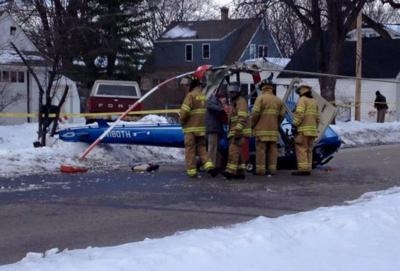Tue, Feb 23, 2016
Pilot Reported Feeling A 'Jolt' Before Losing Power
With any new aircraft comes flight testing, and companies hope nothing goes wrong during those flights.

But Enstrom suffered a setback in the flight test program for its new TH-180 training helicopter, which went down February 12 in a residential neighborhood near the company's headquarters.
According to the NTSB's preliminary report, at about 1123 central standard time, the Enstrom TH-180 helicopter, N180TH, was substantially damaged after it impacted obstructions and terrain during an off-airport emergency landing near Menominee-Marinette Twin County Airport (MNM), Menominee, Michigan. The pilot was not injured. The helicopter was registered to and operated by Enstrom Helicopter Corporation, as a 14 Code of Federal Regulations Part 91 test flight. Visual meteorological conditions (VMC) prevailed and a flight plan had not been filed. The helicopter had departed MNM, about 1057 for a local flight.
The helicopter was on a right base to land on runway 32 when the pilot felt a "jolt" in the airframe and noticed a sudden reduction in rotor rpm, although the engine continued to run. The pilot entered an autorotation and touched down on a city street in a residential neighborhood. During touchdown the main rotor blades struck an electric utility pole as the helicopter slid about 300 feet down the street and came to rest upright. The impacts resulted in the collapse of the skid landing gear and substantial damage to the tail cone, the pylon center section, and the lower section of the cockpit structure. Adequate fuel was found onboard, but there was no fuel spill, and no postimpact fire.
At 1115 the automated surface observation system at MNM, reported wind from 330 degrees at 13 knots with gusts to 24 knots, visibility 10 miles, broken clouds at 4,300 feet, temperature minus 10 degrees Celsius (C), dew point minus 19 degrees C, with an altimeter setting of 30.06 inches of mercury.
(Source: NTSB. Image from file)
More News
From 2023 (YouTube Version): Legacy of a Titan Robert (Bob) Anderson Hoover was a fighter pilot, test pilot, flight instructor, and air show superstar. More so, Bob Hoover was an i>[...]
Get The Latest in Aviation News NOW on Instagram Are you on Instagram yet? It's been around for a few years, quietly picking up traction mostly thanks to everybody's new obsession >[...]
Aero Linx: B-52H Stratofortress The B-52H Stratofortress is a long-range, heavy bomber that can perform a variety of missions. The bomber is capable of flying at high subsonic spee>[...]
Altimeter Setting The barometric pressure reading used to adjust a pressure altimeter for variations in existing atmospheric pressure or to the standard altimeter setting (29.92).>[...]
"Knowing that we play an active part in bettering people's lives is extremely rewarding. My team and I are very thankful for the opportunity to be here and to help in any way we ca>[...]
 Classic Aero-TV: Remembering Bob Hoover
Classic Aero-TV: Remembering Bob Hoover ANN FAQ: Follow Us On Instagram!
ANN FAQ: Follow Us On Instagram! ANN's Daily Aero-Linx (05.15.24)
ANN's Daily Aero-Linx (05.15.24) ANN's Daily Aero-Term (05.15.24):Altimeter Setting
ANN's Daily Aero-Term (05.15.24):Altimeter Setting Aero-News: Quote of the Day (05.16.24)
Aero-News: Quote of the Day (05.16.24)



